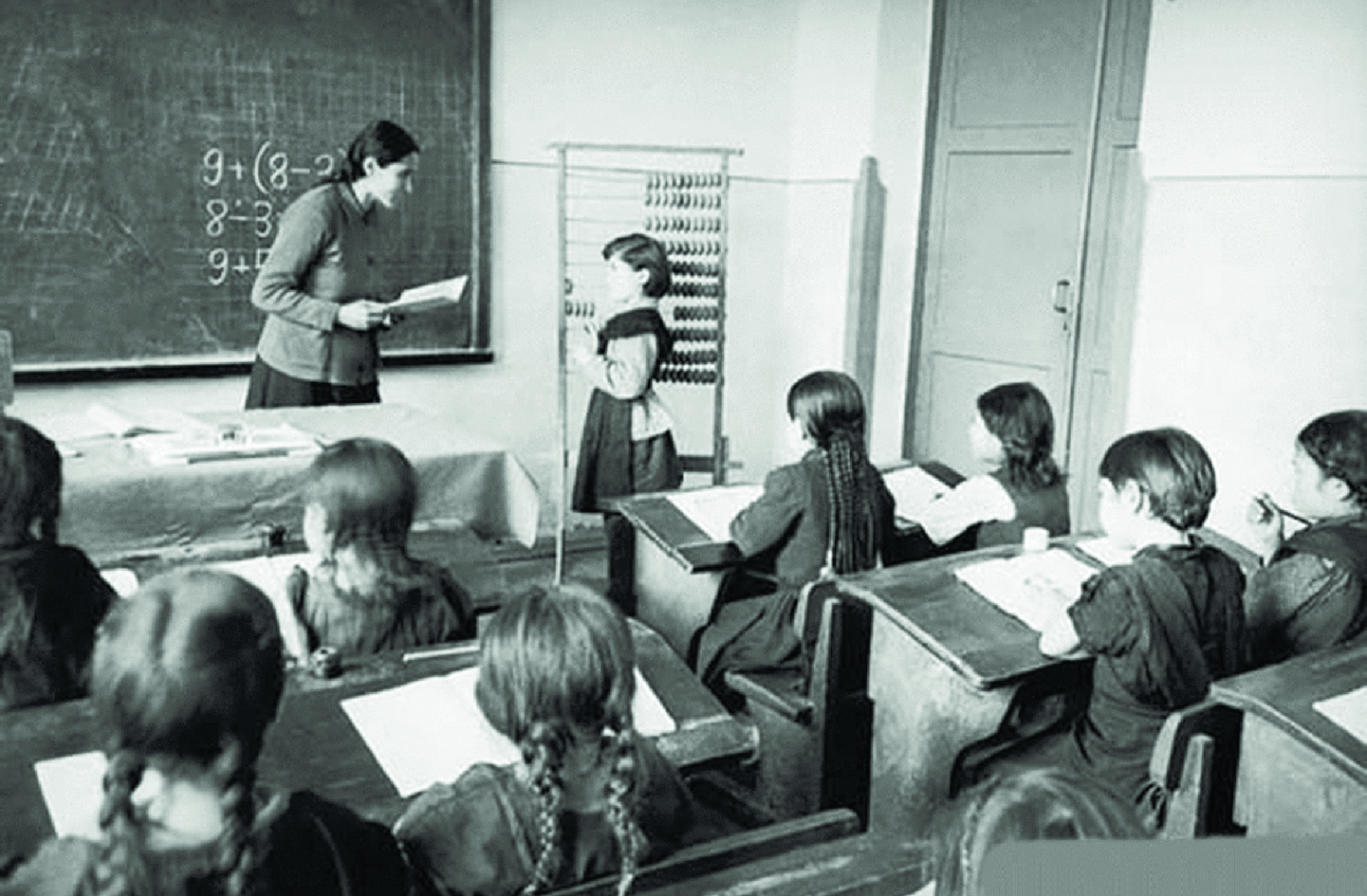Here is a new twist? From pedagogy to andragogyka, from andragogy to hivtogogike
Those who work with information technology have to learn continuously. But adults cannot learn according to the same principles as schoolchildren: our ability to perceive information changes throughout life. Research in this area has led to the emergence of a new educational concept, and the information boom, the proliferation of mobile Internet devices and the development of social networks have predetermined another shift in the educational paradigm.
In this article I will describe how educational concepts evolved, on which principles of adult education modern educational centers rely on and what will change in education in the near future.

Education is considered one of the most conservative areas of human activity. However, in the theory of learning, big changes happen from time to time. One of these changes happened in the middle of the last century: a separate section of the theory of learning was formed - adult education, or "andragogy."
')
The need to "pump" a large amount of complex technical information in a short time into adult minds inevitably led to the study of the characteristics of an adult as a subject of the learning process. One of the first examples of such a task is the training of soldiers during the Second World War. A relatively recent example is the training of IT professionals.
We all know very well the traditional school and university approach to learning. This training is mainly content-oriented, and the teacher is at the center of the educational process. He is the unquestioned authority.

A source
The approach is focused on mass learning of a group of students that is more or less homogeneous in terms of the initial level of knowledge and experience. Often, students have no experience, and their mind is “a clean, white sheet of paper.” In school classes, at least 20 students usually attend, and during lectures at universities, the number of students may exceed one hundred. Programs in schools and universities are long-term and focused primarily on obtaining fundamental knowledge. And, more importantly, the school and the university should teach the younger generation to consciously learn and work.
What is the difference between the approach to learning within the framework of andragogy ?

A source
If we talk about the training of IT professionals, then every self-respecting IT vendor has a program of training and certification (examinations) for teachers, which is based on the principles of andragogy, and training centers leading such training programs are required to have trained teachers on staff.

A source
These postulates have been adopted by the training centers in the field of information technology. The network of such institutions, mainly commercial, has developed in Russia by the beginning of this century.
But gradually the situation in education began to change qualitatively again. This is due to several factors.

A source
Thus, at the beginning of this century, the theory of a new approach to learning began to take shape, which became known as “hyuthogogics” (etagogics).
The term "hjutagogika" or "eutagogika" (two equivalent translations of English heutagogy) was formulated in a scientific article by Australian educators and scholars Stewart Hase and Chris Kenyon in 2000. This term, by analogy with "pedagogy" and "andragogykoy", is constructed from Greek words that appeal to independent search, discoveries and conclusions.

A source
Hyutagogy is not opposed to andragogy and does not cancel it, but is its continuation, the next step in which the student assumes the role of a leader in the educational process. He not only independently searches for and selects information, but also selects methods and methods of teaching. So, the student must represent the essence of such options and evaluate their effectiveness.
The role of the teacher is also changing. It is best to describe his mission with the foreign term “facilitator” (the person providing successful group communication). He monitors compliance with the rules of the meeting, its procedures and regulations. The facilitator allows its participants to concentrate on the goals and content of the meeting.
In order to implement the principles of hyutology in the educational process, approaches to the production of educational content should be studied, revised and adjusted. Obviously, it should be as clear as possible, be submitted using game components and, preferably, in small portions in different formats.
Now the effectiveness of self-study is one of the main topics when discussing the issue of corporate training. This is due to the fact that all large organizations (including our group of companies) have already introduced e-learning systems, which, as a rule, imply self-study as the main form of education.
At the same time, everyone understands that there is little conversion of those who began to study independently, and those who completed this training without additional organizational and methodological efforts. Independent learning should be “fueled” by the external energy of experts, tutors, motivators, and other listeners. The form of submission and the availability of material, the duration of the educational unit - everything has meaning and significance, otherwise the interest in self-study is lost.
A number of personnel training specialists point out the overall low self-study culture in Russia. Using the elements of self-learning in the “Network Academy” courses, we also often note that specialists are not ready to accept proactive forms of independent learning. For example, students cannot critically perceive information and ask questions to the teacher, but are more focused on the traditional approach when the teacher asks questions about the material studied. It can be difficult for students to independently control the quality of learning. That is, it is difficult for an adult raised by the traditional education system and accustomed to the passive perception of new information to adapt to the new system.

A source
Therefore, it is better to change the approach to learning from childhood, at school or even earlier. It is very important to teach people to learn independently and consciously, because properly built independent learning will be able to compete in effectiveness with online learning.
Many companies are experimenting with the methodology of self-learning and the motivation of listeners, intuitively using the provisions of hjutagogiki. At the hearing, such approaches and learning practices as micro-learning, sms-training, mobile learning, blended learning, etc. We also conduct experiments and introduce practices and tools that have proven their effectiveness (for example, the so-called "personal training"). At the same time, "backdating" we understand that basically all innovations we introduce belong to the approach in the spirit of hju-togogiki.
For example, we are changing the role of the teacher, making him more a consultant, directing self-study of students, rather than a lecturer, or giving more freedom to students in the choice of material for study. But it is always better to understand the general principles of the construction of training, than to use the method of "scientific at random".
At one time, the study of the principles of andragogy greatly helped us in building mass education for adult students. I do not know whether conscious attempts have been made in Russia to build self-directed learning (if there are such examples, please share). In the world, such studies have been conducted, for example, in postgraduate education of project management at the University of Hull .
Changes in approaches to corporate training (and, probably, in education in general) are coming, and they are inevitable and are already taking place. Business needs specialists who can make independent decisions and bring them to the result. The ability to direct their own independent learning is undoubtedly correlated with such a business requirement.

A source
While the new concept of adult learning is in the process of thinking, generating ideas, making trial and error. We are waiting for change and are preparing for it. Do you notice how the approaches to education have changed in recent decades?
Below is a small survey on this topic, and we think it will be interesting for everyone to learn how Habr's readers learn.
In this article I will describe how educational concepts evolved, on which principles of adult education modern educational centers rely on and what will change in education in the near future.

Education is considered one of the most conservative areas of human activity. However, in the theory of learning, big changes happen from time to time. One of these changes happened in the middle of the last century: a separate section of the theory of learning was formed - adult education, or "andragogy."
')
Although the term “andragogy” itself was introduced by the German historian-teacher Alexander Kapp one hundred years earlier, in the 19th century, the theory of teaching an adult audience was really developed only in the middle of the 20th century.
The need to "pump" a large amount of complex technical information in a short time into adult minds inevitably led to the study of the characteristics of an adult as a subject of the learning process. One of the first examples of such a task is the training of soldiers during the Second World War. A relatively recent example is the training of IT professionals.
We all know very well the traditional school and university approach to learning. This training is mainly content-oriented, and the teacher is at the center of the educational process. He is the unquestioned authority.

A source
The approach is focused on mass learning of a group of students that is more or less homogeneous in terms of the initial level of knowledge and experience. Often, students have no experience, and their mind is “a clean, white sheet of paper.” In school classes, at least 20 students usually attend, and during lectures at universities, the number of students may exceed one hundred. Programs in schools and universities are long-term and focused primarily on obtaining fundamental knowledge. And, more importantly, the school and the university should teach the younger generation to consciously learn and work.
What is the difference between the approach to learning within the framework of andragogy ?
- The most important thing is that adult listeners have accumulated baggage and experience. This experience should be taken into account in the learning process. If you ignore the experience already available to students, learning becomes ineffective and meaningless. At the same time, the experience of different listeners varies significantly. Often, teachers have to "fight" with established stereotypes.
- Significantly changing the role of the teacher . This is no longer the unquestioned authority, but the “mere mortal”. The teacher is not above the student team, but inside. He is a conductor, an organizer, his task is to lead his group into a "bright future." Listeners are equal members of their group and can influence the direction of movement. Authoritarian, team style of conducting occupations is inadmissible.

A source
If we talk about the training of IT professionals, then every self-respecting IT vendor has a program of training and certification (examinations) for teachers, which is based on the principles of andragogy, and training centers leading such training programs are required to have trained teachers on staff.
In our training center “Networking Academy LANIT” we always cautiously recruit already established school teachers and university professors. Not all of them manage to overcome their usual views on the learning process and restructure.

A source
- Students can have very different learning motivations , and this must be taken into account. Without a personal approach to each listener in such a situation is not enough.
- Adult education is usually short-term and intensive . It is impossible to stretch the program in order not to tear specialists for long from their work duties. In our training center, the duration of courses is usually 5 days, with 8 academic hours each.
Since information technology education is applied, course content is quickly becoming obsolete. Now the usual update period for technical IT courses is no more than two years.
- To ensure the effectiveness of training, following the principles of andragogy, the number of students in a group should be small, in the region of 10 people.
These postulates have been adopted by the training centers in the field of information technology. The network of such institutions, mainly commercial, has developed in Russia by the beginning of this century.
But gradually the situation in education began to change qualitatively again. This is due to several factors.
- The procedure for publishing information has become very simple and accessible to everyone, and the speed of information dissemination is almost instantaneous. This is due to the development of the Internet, search engines and social networks.
- The use of electronic gadgets connected to high-speed mobile networks has become ubiquitous - first of all, we are talking about smartphones and tablets. This factor has changed not only the approaches to the development and distribution of software, but also increased the availability of educational content. Now, in fact, any person can get access to educational materials at any time and from any place on Earth and even space.

A source
- The development of computer technology and backbone data networks now allows you to store and quickly transfer huge amounts of complex data . For the most part, educational content from primarily text-graphic has become multimedia-interactive.
- E-learning (elearning), as well as simple tools for the preparation of e-learning materials have become a given, a reality of today.
Thus, at the beginning of this century, the theory of a new approach to learning began to take shape, which became known as “hyuthogogics” (etagogics).
Elearning actively talked about e-learning in the 90s of the last century, which was associated with the growing availability of personal computers and the development of the Internet. Then in the West, there were schools with distance education for students from distant settlements. Today, the use of e-learning is a common practice not only for schools and universities, but also for business.
The term "hjutagogika" or "eutagogika" (two equivalent translations of English heutagogy) was formulated in a scientific article by Australian educators and scholars Stewart Hase and Chris Kenyon in 2000. This term, by analogy with "pedagogy" and "andragogykoy", is constructed from Greek words that appeal to independent search, discoveries and conclusions.

A source
Hyutagogy is not opposed to andragogy and does not cancel it, but is its continuation, the next step in which the student assumes the role of a leader in the educational process. He not only independently searches for and selects information, but also selects methods and methods of teaching. So, the student must represent the essence of such options and evaluate their effectiveness.
HYUTAGOGY is a creative approach to self-study, which will allow the student to determine for himself what, when and how he will learn.
The role of the teacher is also changing. It is best to describe his mission with the foreign term “facilitator” (the person providing successful group communication). He monitors compliance with the rules of the meeting, its procedures and regulations. The facilitator allows its participants to concentrate on the goals and content of the meeting.
In order to implement the principles of hyutology in the educational process, approaches to the production of educational content should be studied, revised and adjusted. Obviously, it should be as clear as possible, be submitted using game components and, preferably, in small portions in different formats.
Now the effectiveness of self-study is one of the main topics when discussing the issue of corporate training. This is due to the fact that all large organizations (including our group of companies) have already introduced e-learning systems, which, as a rule, imply self-study as the main form of education.
At the same time, everyone understands that there is little conversion of those who began to study independently, and those who completed this training without additional organizational and methodological efforts. Independent learning should be “fueled” by the external energy of experts, tutors, motivators, and other listeners. The form of submission and the availability of material, the duration of the educational unit - everything has meaning and significance, otherwise the interest in self-study is lost.
A number of personnel training specialists point out the overall low self-study culture in Russia. Using the elements of self-learning in the “Network Academy” courses, we also often note that specialists are not ready to accept proactive forms of independent learning. For example, students cannot critically perceive information and ask questions to the teacher, but are more focused on the traditional approach when the teacher asks questions about the material studied. It can be difficult for students to independently control the quality of learning. That is, it is difficult for an adult raised by the traditional education system and accustomed to the passive perception of new information to adapt to the new system.

A source
Therefore, it is better to change the approach to learning from childhood, at school or even earlier. It is very important to teach people to learn independently and consciously, because properly built independent learning will be able to compete in effectiveness with online learning.
Many companies are experimenting with the methodology of self-learning and the motivation of listeners, intuitively using the provisions of hjutagogiki. At the hearing, such approaches and learning practices as micro-learning, sms-training, mobile learning, blended learning, etc. We also conduct experiments and introduce practices and tools that have proven their effectiveness (for example, the so-called "personal training"). At the same time, "backdating" we understand that basically all innovations we introduce belong to the approach in the spirit of hju-togogiki.
For example, we are changing the role of the teacher, making him more a consultant, directing self-study of students, rather than a lecturer, or giving more freedom to students in the choice of material for study. But it is always better to understand the general principles of the construction of training, than to use the method of "scientific at random".
At one time, the study of the principles of andragogy greatly helped us in building mass education for adult students. I do not know whether conscious attempts have been made in Russia to build self-directed learning (if there are such examples, please share). In the world, such studies have been conducted, for example, in postgraduate education of project management at the University of Hull .
Changes in approaches to corporate training (and, probably, in education in general) are coming, and they are inevitable and are already taking place. Business needs specialists who can make independent decisions and bring them to the result. The ability to direct their own independent learning is undoubtedly correlated with such a business requirement.

A source
While the new concept of adult learning is in the process of thinking, generating ideas, making trial and error. We are waiting for change and are preparing for it. Do you notice how the approaches to education have changed in recent decades?
Below is a small survey on this topic, and we think it will be interesting for everyone to learn how Habr's readers learn.
Source: https://habr.com/ru/post/343396/
All Articles